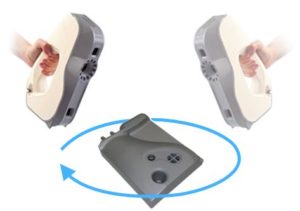If you’ve seen a 3D scanner in action, you know that scans can be accomplished quickly and used to create detailed digital models of just about any object. But moving a scanner around a subject is a deceptively simple act—there’s a lot more going on beneath the surface.
Whether you’re thinking of purchasing an Artec 3D scanner or you’re interested in terrestrial scanning services for a large project, we’re here to provide a more in-depth look at exactly what happens during a scan. Let’s dive into the inner workings of 3D scanners and the 3D scanning process.
What Is a 3D Scanner?
3D scanners come in a variety of shapes and sizes, from portable to stationary to desktop. Some may sit on a tripod for long-range scanning applications indoors and out, while others include handheld and lab based systems with higher accuracy and resolution. All of the line of sight machines use sensors to capture light changes over an object to digitally measure its physical geometry. The process requires no contact and is non-destructive, making it ideal for sensitive applications, such as preserving historical artifacts.
The intended end use will determine the exact type of scanner needed, but these machines are incredibly versatile and can be used to survey a variety of objects. You really can scan just about anything, from industrial parts to living creatures to moving targets to massive buildings and environments. Portable Artec 3D scanners might be used out in the field, while a desktop scanner might be better suited for laboratory use. If you only require the use of a scanner for a short period, you might employ 3D scanning services instead of outright purchasing your own scanner.
Combining high resolution with accuracy, 3D scanners capture a huge amount of shape data quickly and efficiently. Some units, like the Artec Eva, can record both shape and color, resulting in a detailed, fully textured 3D image. Many portable scanners are designed to be simple to use, making capturing data as simple as recording a video. The Artec Leo, for example, boasts a built-in touch panel screen that allows users to watch the 3D model developing as they scan.
How Does 3D Scanning Work?
3D scanners are an effective option for creating digital copies of objects with fine details or irregular geometries, thanks to the precise nature of 3D scanning. The first step in this process is conducting the scan and capturing the data. To do this, a pattern of light is projected onto the subject, while cameras measure and record the resulting changes in the distance and shape of the pattern in three dimensions through a process known as triangulation.
That very precise pattern of light allows a 3D scanner to capture millions of data points on an object from a single setup or orientation — the resulting XYZ measurement points are referred to as a point cloud. Multiple point clouds will need to be created in order to capture the object in question from every perspective. Once all of the necessary point clouds have been created (think of this as the raw scan data), they are combined to form one 3D digital representation of the object.
Where Does 3D Scanning Software Come In?

Once the scan is complete, you’re left with a complete set of data points to edit and manipulate. 3D scanning software is used for a variety of post-processing needs, from registering to aligning data. Programs like Artec Studio can transform a scan for a variety of applications, such as creating and exporting models that are directly compatible with CAD. Although the software might seem overwhelming at first glance (it’s jam-packed with dozens of tools!), most projects can be tackled with the help of just a few main functions or even fully automated for efficiencies.
What Are 3D Scans Used For?
Portable scanners, like those included in the Artec line, have been instrumental in bringing this technology out of the lab and into a variety of fields. Today, 3D scanners are used in an enormous variety of industries—the medical, engineering, archeological, and animation sectors are just a few areas that have benefited immensely from this equipment.
Once your scan is complete and you’re finished with post-processing, you’ll be able to use your data to create everything from CAD models to 3D-printed figurines. In the last 30 years, we’ve seen our fair share of imaginative 3D scanning projects, from analyzing a potentially ancient runestone to body scanning the entire U.S. Women’s National Soccer Team to reverse engineering a one of a kind aircraft. The bottom line is that this technology, while complex in its inner workings, is simple to use and can accomplish exactly what you need it to do.
Ready to Incorporate 3D Scanning Into Your Workflow?
Whether you’ve handled a number of different scanners or have never touched one in your life, Laser Design, a brand of CyberOptics® Corporation, can help you incorporate an Artec 3D scanner and 3D scanning software into your project in no time. Contact us today for more information on our products and services—we’re always happy to answer questions!
